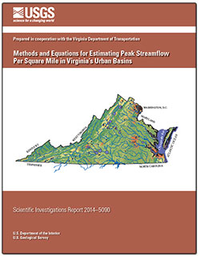Models are presented that describe Virginia urban area annual peak streamflow per square mile based on basin percent urban area and basin drainage area. Equations are provided to estimate Virginia urban peak flow per square mile of basin drainage area in each of the following annual exceedance probability categories: 0.995, 0.99, 0.95, 0.9, 0.8, 0.67, 0.5, 0.43, 0.2, 0.1, 0.04, 0.02, 0.01, 0.005, and 0.002 (recurrence intervals of 1.005, 1.01, 1.05, 1.11, 1.25, 1.49, 2.0, 2.3, 5, 10, 25, 50, 100, 200, and 500 years, respectively). Equations apply to Virginia drainage basins ranging in size from no less than 1.2 mi2 to no more than 2,400 mi2 containing at least 10 percent urban area, and not more than 96 percent urban area. A total of 115 Virginia drainage basins were analyzed. Actual-by-predicted plots and leverage plots for response variables and explanatory variables in each peak-flow annual exceedance probability category indicate robust model fits and significant explanatory power. Equations for 8 of 15 urban peak-flow response surface models yield R-square values greater than 0.8. Relations identified in statistical models, describing significant increases in urban peak stream discharges as basin urban area increases, affirm empirical relations reported in past studies of change in stream discharge, lag times, and physical streamflow processes, most notably those detailed for urban areas in northern Virginia.


